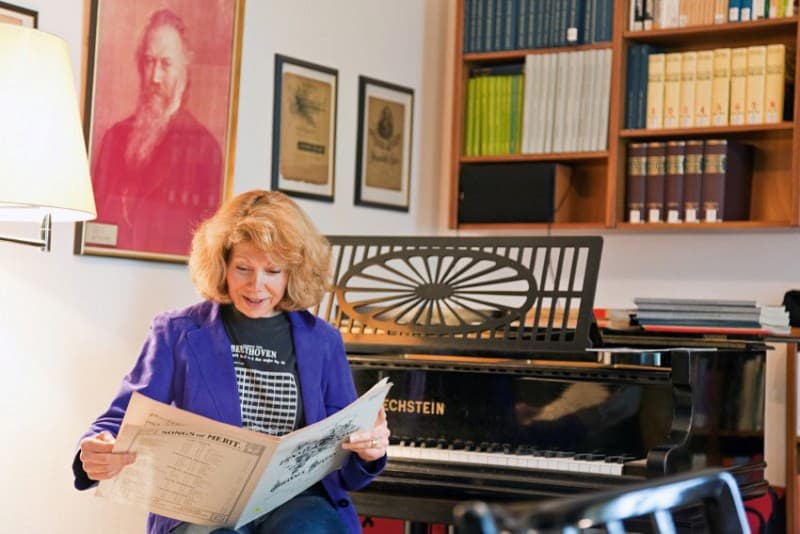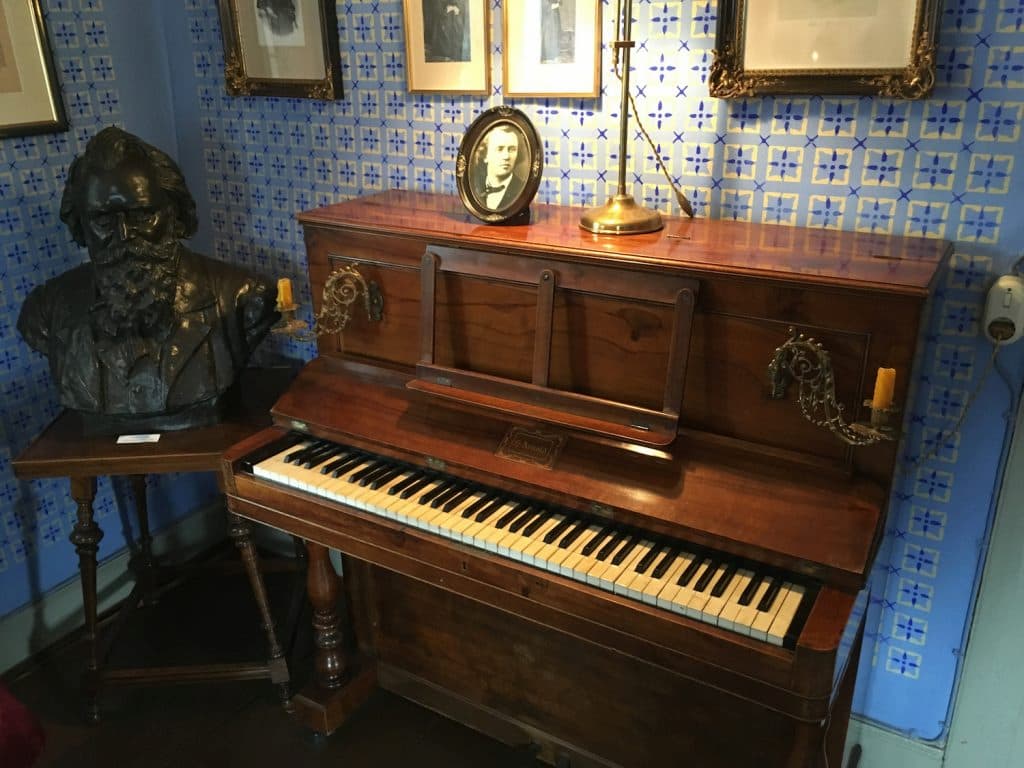The spa town Baden-Baden is located in the German state of Baden Württemberg, at the border of the Black Forest and within ten kilometers of the Rhine River. The Romans knew the curing springs at Baden-Baden, and in the 19th century, it became a meeting and partying place for various celebrities. Guests included Queen Victoria, Wilhelm I, Hector Berlioz, Clara Schumann, and Johannes Brahms.

Brahmshaus Baden-Baden
In fact, Brahms spent his summers from 1865 to 1874 in Baden-Baden. Specifically, he stayed in house No. 8 in the district of Lichtental. Brahms was drawn to Baden-Baden not only by the hot springs, but also by Clara Schumann who lived with her children in a house at the Lichtentaler Allee. Clara had invited Brahms for a visit, and full of enthusiasm for the landscape and its natural beauty, he returned summer after summer. As he wrote to his father, “Here one sees all kinds of people, the most beautiful of surroundings, and so it is bearable.” The Brahms house is located on a steep hill, and in its day, it was largely isolated. In the 1960s, the house was slated for demolition but was saved in time by funds and donations from the newly formed Brahms Society of Baden-Baden. Renovations began in 1967, and the “Brahms-Hause Museum” opened to the public in 1968.
Johannes Brahms: Piano Quintet in F minor, Op. 34
Today, the museum continues to be curated and maintained by the Brahmsgesellschaft Baden-Baden. Sadly, I have not yet been able to visit this location, but a recent visitor writes, “The upstairs rooms are carefully maintained, with Brahms’s former living quarters now turned into a museum. One room contains a variety of photos, autographs, and other documents.

Victoria Bond at Brahms House Baden Baden
Two other rooms recreate Brahms’s living room and bedroom. There are at least two original items in the space: a bright red day bed and an upright piano.” Apparently, the “lower keys of the piano are substantially worn down, suggesting that the composer had a particularly aggressive left hand.” Brahms felt rather comfortable in Baden-Baden, and he took long morning walks in the surrounding woodlands. He mingled with fellow musicians and with authors and painters. During his summers in Baden-Baden, Brahms worked on a number of significant compositions, including the First and Second Symphonies, the Piano Quintet in F minor, and the German Requiem.
Johannes Brahms: String Sextet in G major, Op. 36
So, how do we get from Johannes Brahms to Victoria Bond? The Brahms-Haus Museum actually also houses a guest apartment, made available for musicians and scholars for residency. “I spent 2002,” Victoria Bond writes, “in a very sacred place: the house where Johannes Brahms spent many summers composing and hiking in the Black Forest. I had been awarded a stipendium or grant from the Brahms Society Baden-Baden, Germany to spend the month of June in this house, now converted into a museum and an artist’s residence. I had received this grant once before, and six years ago, I discovered this inspiring environment. It seemed the ideal place to compose, particularly a piano concerto. This instinct proved true, and I awoke each morning at dawn, spending the morning hours immersed in writing and the afternoon hiking those very same paths that the Master had walked so many years before. There seemed to be a continuity and an encouragement. Although Brahms’s contribution to the literature is above mere mortal understanding, his presence and his mighty legacy was a beacon leading me on.”

Brahms’ piano © Brian Wise
The idea for Bond’s piano concerto Ancient Keys, according to the composer, “began as a fragile melody sung by the pianist Paul Barnes on a foggy hillside in the Czech city of Zlin.” On the way to a recording session for her first piano concerto, they stopped at a Greek Orthodox Church and listened to a choir. “I asked Paul to hum me the melody of one of the chants, and he sang, in a beautiful and dear voice, a melody, which in Greek is called “Potirion Sotiriu” meaning “Cup of Salvation” in English. The melody was haunting in its purity and profundity, and I resolved, then and there, to incorporate it into a piano piece for Paul. Thus began a long and fascinating journey of discovery, exploring how this melody related, not only to the mystical chants of the Greek Orthodox Church but also to my own Jewish background.” The meditative melody evoked a universal peace and contemplation of the wonder of creation in the composer, and the first version of the melody was a solo piano work called “Potirion Sotiriu.” Barnes performed it extensively around the world, and this often included an actual choir singing the original melody both before and after the piano version. “When I had the opportunity to expand the solo piano piece into a piano concerto, I decided to incorporate the sound of those deep, resonant voices into the orchestra. I pictured an enormous space, filling up with rich bass tones rising and swirling around, gradually disappearing like delicate smoke into a high dome. This would be a cleansing bath of sound that could purify and refresh all who heard it.” For Bond, the piano acts as a spiritual guide, “leading the listener through the healing sounds.”
Victoria Bond: Ancient Keys (Paul Barnes, piano; Slovak Radio Symphony Orchestra; Kirk Trevor, cond.)

Victoria Bond with Clara Schuman Statue, Baden Baden
Victoria Bond is an acclaimed composer, conductor, lecturer, and the artistic director of “Cutting Edge Concerts.” Major publications call her compositions “powerful, stylistically varied and technically demanding,” and her conducting “impassioned and full of energy and fervor.” Victoria Bond is the first woman awarded a doctorate in orchestral conducting from the Juilliard School, and she has served with countless national and international symphony and chamber orchestras. Thus far, Bond has composed eight operas, six ballets, two piano concertos and numerous orchestral, chamber, choral and keyboard compositions. Her residency in Baden-Baden also inspired the opera Clara, based on the life of composer and pianist Clara Schumann. The German press wrote: “Victoria Bond gives each character a three-dimensional role, enriched with original musical colors.”
The story of Clara and Robert has predictably attracted much attention. For Bond, it is a fascinating love story because it is so timeless and because they communicated their innermost feelings for each other in music…It is a passionate story, but also tragic as Robert’s mental breakdown impacted their lives. It is ultimately a story about music itself and its power to transform. The opera emphasizes Clara’s inner life and the conflicts of a woman struggling to balance “the demands of those who depend on her against her rising consciousness of her own need.” As director Carmen C. Kruse writes, “Clara’s musicianship is secondary: With no piano on stage, we never see anyone playing or composing music. Clara exists in relation to the three main men in her life—her father, Robert, and Brahms—as she matures out of docile acceptance of their expectations to recognizing and claiming the legitimacy of her artistic and personal worth.” The music is largely tonal, and as the composer explains, “quotes fragments of music from Clara, Robert, and Johannes Brahms, woven together with my own original music around their melodies, rhythms, and harmonies.” We can hear the familiar melodies transforming into a more dissonant and harsher instrumental narrative. Clara’s inner monologues are “cast in a chant-like style reminiscent of Poulenc, while her outward-looking solos and duets are more melodic.”
For more of the best in classical music, sign up for our E-Newsletter

